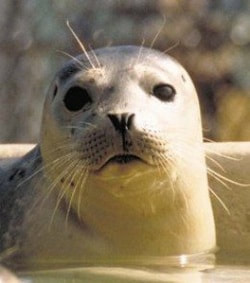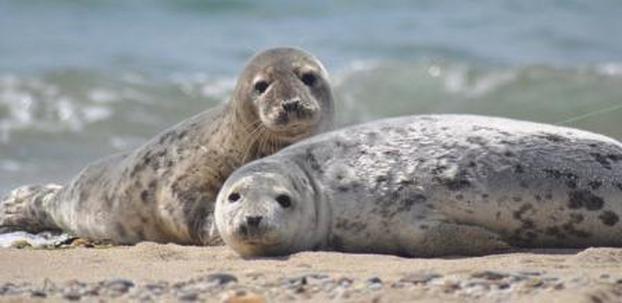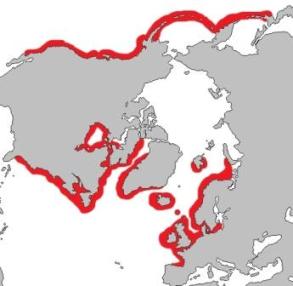Harbor SealPhoca vitulina |

Custom Search
|
|
The harbor seal (Phoca vitulina) is also known as the common seal and can be found in the coastal waters of the North Atlantic and North Pacific, as well as the Baltic and North Seas, being one of the most widely distributed of the pinnipeds (eared seals, true seals, and walruses). There are 5 subspecies currently recognized of Harbor seal.
They typically appear on barrier islands, although they can also be found on rocky shores. The coat is gray or light gray to black and mixed with a pattern of darker spots in various shades. The males measure 1.3 to 1.95 meters long and weigh about 100 kg. Females are slightly smaller and lighter. The Harbor seals (such as seals and other marine mammals in general) have a thick layer of fat under the skin, which protects them from cold. The head is large relative to the body and has V-shaped nostrils. Unlike sea lions, seals do not have ears, and this is one of the features that most easily distinguish these two groups of animals.
They are very well adapted for locomotion in water and move with difficulty on the ground, dragging their body on the ground with the aid of the fins. They are essentially sedentary, although the eating area is quite variable. When found on land resting, known as hauling-out, they gather in large groups, with about 1000 individuals.
The females of harbor seals live longer than males and have an estimated lifespan of 30 to 35 years, while the male lifespan is about 20 to 25 years. They are one of the favorite prey for orcas or killer whales and white sharks. Subspecies There are five subspecies of harbor seal currently recognized by scientists. Eastern Atlantic Common seal (P. v. vitulina - Linnaeus, 1758) - Found in Europe and western Asia. Western Atlantic Common seal (P. v. concolor - DeKay, 1842) - They inhabit the eastern North America waters. Although the validity of this subspecies often disputed. Pacific Common seal (P. v. richardsi - Gray, 1864) - Like its name indicates they are found in western North America waters. Ungava seal (P. v. mellonae - Doutt, 1942) - Found in eastern Canada in fresh water, included in the Western Atlantic Common seal subspecies by some authors. Insular seal (Phoca vitulina stejnegeri - J. A. Allen, 1902) - Found in eastern Asia waters. Diet / Feeding
They feed on fish such as salmon, anchovy, menhaden, herring, sea bass, mackerel, cod, whiting, and flatfish. They will occasionally feed on shrimp, crustaceans, crabs, mollusks, and squid. Juveniles will eat mainly crustaceans. The Harbor seal is also known to attack, kill and eat several species of ducks. They will spend several days at sea traveling up to 31 miles (50 km) in search of prey. The harbor seal can be found freshwater swimming upstream in large rivers, sometimes 100 miles or even more from the ocean. Reproduction The courtship and mating take place in water. Mating takes place after weaning of the offspring born in that year. The gestation period lasts from 10.5 to 11 months, including a period of 45 to 90 days of delayed implantation. The time of birth varies with geographic location (these occur in February, March or April in California, in June or July, in Europe, North Pacific, and North Atlantic Arctic region). The female gives birth to only a pup on land, which is nursed for about four to six weeks. Once born, the offspring is already able to swim and dive. Most Harbor seal males reach sexual maturity at six years of age and females at three to five years of age. Conservation status and main threats The species is not globally threatened (according to the International Union for Conservation of Nature). Pollution is one of the major threat factors, either directly (causing breathing problems) or indirectly (by causing the death of the fish that they feed on). However, protective measures were taken, so it is still relatively common. The once common practice of seal hunting or sealing is now considered illegal in many countries within the harbor seal range. Their global numbers reach 350 to 500 thousand, but some subspecies in certain areas are considered threatened. The subpopulations found in Greenland, Hokkaidō and Baltic Sea populations are considered threatened.
|
Scientific classification
Kingdom: Animalia Phylum: Chordata Class: Mammalia Order: Carnivora Suborder: Pinnipedia Family: Phocidae Genus: Phoca Species: P. vitulina |



